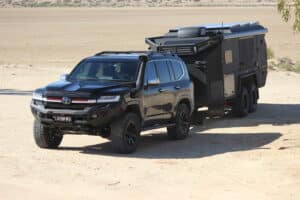Off-road caravan enthusiasts in Australia are spoiled for choice when it comes to exploring stunning landscapes. From the vast Simpson Desert to the pristine beaches along the entirety of the coastline, there’s no shortage of breathtaking destinations waiting to be discovered. However, driving and towing on sand can be a challenging but rewarding experience. In this blog post, we’ll share valuable insights and tips on how to navigate the sandy terrain while keeping your off-road caravan safe and sound.
Understanding the Terrain
Know Your Terrain: Before embarking on a sand adventure, research and understand the specific terrain you’ll be driving on. Is it a beach, desert, or dunes? Different sand types require different techniques.
Tire Pressures: Lower your tire pressures to around 18-20 psi for improved traction on sand. This increases the tire’s footprint and minimises the chances of getting stuck. This is just a guide however and can vary greatly depending on the surface.
Preparing Your Off-Road Caravan
Weight Distribution: Ensure proper weight distribution within your caravan. Heavy items should be secured low and evenly to maintain stability.
Reduce Payload: Take only essential items, keeping your caravan as light as possible. This makes it easier for your towing vehicle to handle.
Towing on Sand
Use a Suitable Vehicle: Choose a four-wheel-drive (4WD) vehicle with high ground clearance, low-range and locking differentials. It’s essential to have a capable tow vehicle for sandy terrains.
Reduce Speed: Drive at a safe and steady pace. Higher speeds can cause your tires to dig in, leading to traction loss.
Maintain Momentum: If you feel your vehicle bogging down, avoid abrupt stops. Keep a steady momentum, and use the vehicle’s weight to your advantage.
Recovery and Safety
Traction Aids: Carry essential recovery gear, including sand ladders, traction boards, and a sturdy tow strap. These tools can make the difference between getting stuck and getting back on track.
Communicate: If you’re traveling with a group, establish clear communication channels. Hand signals or CB radios are useful for maintaining contact, especially when visibility is low.
Safety First: Always prioritise safety. Avoid towing on sand at night, and be aware of the tides if you’re on the beach. Check weather conditions before setting out and be prepared for emergencies.
Environmental Considerations
Respect the Environment: Stick to designated tracks and avoid driving over fragile dunes and vegetation. Leave no trace, and dispose of waste responsibly.
Check Local Regulations: Familiarise yourself with local regulations and permits required for off-road driving in specific areas. Some places may have restrictions to protect the environment.
Conclusion
Driving and towing on sand in Australia can be a thrilling and memorable experience for off-road caravan enthusiasts. However, it requires careful planning, the right equipment, and a commitment to safety and environmental preservation. By following these tips, you can enjoy the beauty of Australia’s sandy landscapes while preserving them for future generations. So, gear up, get ready, and embark on your next sandy adventure with confidence.


